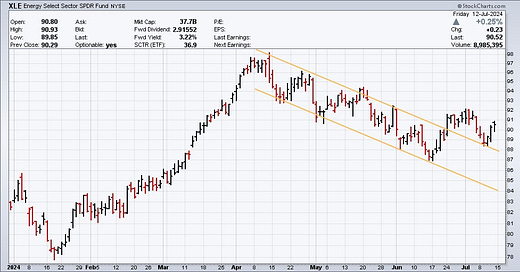After a fantastic run to start the year, the past three months have not been kind to the energy sector.
The sector, as depicted by XLE, the popular ETF, peaked in early April 2024 and then tumbled down through a descending channel ever since then. The boundaries of that channel are in yellow in the chart above.
Such channels often appear on stock charts, but when and where they appear is rarely ever known in advance. Back in April, probably nobody predicted that XLE would have a slow, orderly decline lasting 2+ months. It is only afterward that we can look at a chart and say - Hey! There’s a channel!
That is where we are today.
The point of this article is not about XLE being in a channel but, rather, what happened once it finally escaped during the last week of June. As is often the case, after prices broke above the channel they reversed and headed back to what would have been the upper boundary.
On 9-10 July XLE tagged the upper boundary of the channel and then bounced higher. This is the polarity principle that you see so often on stock charts. Something that had previously been a source of resistance is now a place of support.
This is a bullish development, of course. Some traders will want to speculate that the energy sector is headed higher. Others will prefer to wait until $92 is conquered, since that is where the market stalled a couple weeks ago.
More charts
The Plight Of The Largest 7 Ned Davis Research with a fascinating chart of the performance of the “largest 7” stocks in the S&P 500 throughout history.
David Settle, CMT shows us what happens next when TSLA goes up 40% or more in 11 days. More surprising is that this has happened multiple times.
The weekly AAII Investor Sentiment Survey reported the highest percentage of bulls since the end of March.
Numbers only
3.1% - The recent seven day winning streak for the S&P 500, which came to an end last week, amounted to a cumulative gain of 3.1%.
331 - On Friday, the number of new 52-week highs on the NASDAQ reached its highest level since March..
18.4% - According to Refinitiv, 2Q 2024 earnings for the Russell 2000 are expected to increase 18.4% year-over-year.



